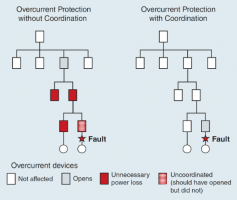jar546
CBO
I know this is a state-by-state and jurisdiction-by-jurisdiction answer, which is why I am posting it here on The Building Code Forum (TBCF). To hone in on more specific answers, I am using a specific code to see how you handle compliance. The waters will be rather muddy with this one.
NEC 240.12 Orderly Shutdown is the code section we will use, which reads:
Where an orderly shutdown is required to minimize the hazard(s) to personnel or equipment, a system of coordination based on the following two conditions shall be permitted:
In some circumstances, an orderly shutdown of a system or process is more critical to personnel and equipment safety than is the automatic operation of the OCPD in response to an overload. Examples of overcurrent protection with and without coordinated protection are illustrated in the following exhibit.

QUESTIONS
NEC 240.12 Orderly Shutdown is the code section we will use, which reads:
Where an orderly shutdown is required to minimize the hazard(s) to personnel or equipment, a system of coordination based on the following two conditions shall be permitted:
- (1) Coordinated short-circuit protection
- (2) Overload indication based on monitoring systems or device
In some circumstances, an orderly shutdown of a system or process is more critical to personnel and equipment safety than is the automatic operation of the OCPD in response to an overload. Examples of overcurrent protection with and without coordinated protection are illustrated in the following exhibit.

QUESTIONS
- Who determines when an orderly shutdown is required?
- Is an electrician qualified to make this decision?
- When was the last time you did plan review and cited NEC 240.12?
